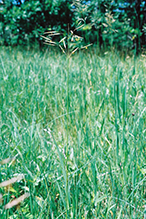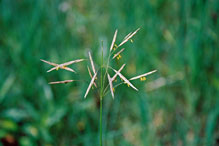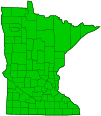smooth brome
(Bromus inermis)
Conservation • Weed • Wetland • Description • Habitat • Ecology • Use • Distribution • Taxonomy
Description |
||
|
||
Height |
||
36″ to 48″ |
||
Similar Species |
||
Habitat |
||
Roadsides, pastures, disturbed sites. |
||
Ecology |
||
Flowering |
||
Early to late June |
||
Pests and Diseases |
||
|
||
Use |
||
|
||
Distribution |
||||
|
Sources |
|||
| 6/18/2023 | ||||
Nativity |
||||
Native to Europe and Asia. Introduced and naturalized. |
||||
Occurrence |
||||
Very common |
||||
Taxonomy |
|||
| Kingdom | Plantae (Plants) | ||
| Division | Tracheophyta (Vascular Plants) | ||
| Subdivision | Spermatophytina (Seed Plants) | ||
| Class | Liliopsida (Monocots) | ||
Order |
Poales (grasses, sedges, cattails, and allies) | ||
Family |
Poaceae (grasses) | ||
| No Rank | BOP clade | ||
| Subfamily | Pooideae | ||
| Supertribe | Triticodae | ||
| Tribe | Bromeae | ||
Genus |
Bromus (bromes) | ||
| Section | Bromopsis | ||
Synonyms |
|||
Bromopsis inermis Bromopsis inermis var. aristata Bromus inermis var. aristatus Bromus inermis var. aristatus Bromus inermis var. aristatus Bromus inermis var. aristatus Bromus inermis f. aristatus Bromus inermis f. aristatus Bromus inermis f. bulbiferus Bromus inermis var. divaricatus Bromus inermis ssp. inermis Bromus inermis ssp. inermis var. divaricatus Bromus inermis ssp. inermis var. inermis Bromus inermis var. inermis Bromus inermis f. proliferus Bromus inermis var. villosus Bromus inermis f. villosus Bromus inermis f. villosus Bromus inopinatus Festuca inermis Festuca inermis var. inermis Festuca inermis var. villosa Forasaccus inermis Poa bromoides Schedonorus inermis Zerna inermis |
|||
Common Names |
|||
awnless brome bromegrass Austrian brome Hungarian brome Russian brome smooth brome |
|||
Visitor Photos |
|||||
Share your photo of this plant. |
|||||
| This button not working for you? Simply email us at info@MinnesotaSeasons.com. Attach one or more photos and, if you like, a caption. |
|||||
|
|||||
MinnesotaSeasons.com Photos |
|||||
Plant |
|||||
 |
|||||
Inflorescence |
|||||
 |
|||||

Slideshows |
||

Visitor Videos |
|||
Share your video of this plant. |
|||
| This button not working for you? Simply email us at info@MinnesotaSeasons.com. Attach a video, a YouTube link, or a cloud storage link. |
|||
Other Videos |
|||
| Difference in types of forage Bromes at the University of Kentucky PASTUREDAVE |
|||
About
Uploaded on May 30, 2011 Watch as we look at the stark differences between types of Bromes! We'll look ta Meadow Brome, Smooth Brome, Alaskan Brome, Mountain Brome, and Prairie Brome. This plot has been in for three winters and this is the third harvest year. I really like the MacBeth Meadow Brome! I think you will too. |
|||
| How to do a Smooth Brome Grass Renovation Project MillbornSeeds |
|||
About
Published on Nov 17, 2013 Jason Tronbak, Conservation and Food Plot Specialist and Certified Wildlife Biologist, of Millborn Seeds, talks about the steps and benefits of a Smooth Brome Grass Restoration project. TRANSCRIPT: We started with a monoculture of brome. We had the guy hay it off. We actually sprayed it a couple times with RoundUp. And the last time he sprayed with RoundUp, we added Plateau at 4 ounces an acre. Plateau is a herbicide we use to establish native grasses. In this mix we happened to use only grasses because he was worried a thistle problem he has in here. So he didn't want to add any wildflowers at this time. We used the common native grasses in this mix. There's some big bluestem, some switchgrass, some side oats, some western wheatgrass, there's a little bit of little bluestem...and there's some indian grass in this mix. Kind of your common six way native grass mix. I will point out some of the main grasses here in a second. I just wanted to show you the first six months of growth we have here. It's pretty typical. You can kind of see behind me the first year of growth of native grasses going to sod. Not extremely ideal conditions. But you can grow the grass out. You got a really good stand for the first year. Again, just wanted to show you the initial steps in the growth of native grasses...and what you can expect the first year when you're changing a monoculture of brome to a native warm season grass. Just wanted again to point out some of the main grasses we have. One of the main grasses that gets used in about every grass planting we do is Big Bluestem. Big Bluestem when it's fully mature will probably reach about four to six feet tall. This is about thirty percent of the mix. The next grass we have in here is switchgrass. Another great warm season grass. When this grass is fully mature it will probably reach a height of about four to five feet tall. These two are about half the mix - big blue and switchgrass. Other grasses we had in the mix was also a side oats grama. This is a short native grass. Being a max height of about two to three foot. But a really stiff stemmed, good short grass to use in native mixes. Another grass we used was western wheatgrass. This is a cool season grass so it means that it will green up early in the year...kind of go dormant in the summer...then green up again here in the Fall. ---- For more information, please visit http://www.millbornseeds.com/conservation.htm |
|||

Visitor Sightings |
|||||
Report a sighting of this plant. |
|||||
| This button not working for you? Simply email us at info@MinnesotaSeasons.com. Be sure to include a location. |
|||||
|
|||||
MinnesotaSeasons.com Sightings |
|||||
Avon Hills Forest SNA, North Unit Bertram Chain of Lakes Regional Park Blazing Star Prairie Addition Preserve, South Unit Carpenter St. Croix Valley Nature Center Carver Highlands WMA, South Unit Charles A. Lindbergh State Park Felton Prairie SNA, Bicentennial Unit John Peter Hoffman Spring Brook Valley WMA Kellogg Weaver Dunes SNA, Kellogg Weaver Unit Lake Alexander Woods SNA, South Unit Margherita Preserve-Audubon Prairie Minnesota Valley NWR, Rapids Lake Unit Mound Spring Prairie SNA, North Unit Mound Spring Prairie SNA, South Unit Northern Tallgrass Prairie NWR, Hoffman Unit Northern Tallgrass Prairie NWR, Pavia Unit Northern Tallgrass Prairie NWR, Rengstorf Unit Northern Tallgrass Prairie NWR, Spieker Unit Northern Tallgrass Prairie NWR, Touch the Sky Prairie Unit Pankratz Memorial Prairie, North Unit Pembina Trail Preserve SNA, Pembina Trail Unit Prairie Creek WMA, Koester Prairie Unit Robert Ney Memorial Park Reserve Sand Prairie Wildlife Management and Environmental Education Area |
|||||

|
Created: Last Updated: © MinnesotaSeasons.com. All rights reserved. |
